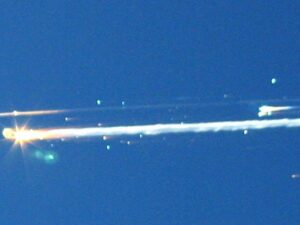David Todd, Seradata’s head of space content, reviews ‘The Space Shuttle that Fell to Earth’, a new BBC documentary marking the 21st anniversary of the fatal Space Shuttle Columbia disaster
In January 2003 the 113th flight of the Space Shuttle program was launched into space. After 15 days in orbit, STS-107 Columbia began its journey home. During the shuttle’s re-entry on 1 February damage to its wing (sustained during its launch) led to the vehicle’s disintegration.

Parts of STS-107 Columbia break up during its fiery re-entry. Courtesy: NASA via US NASM Archive
During the launch, a block of insulation material fell off the external tank. It then struck the leading edge of the shuttle orbiter’s left wing and created a hole. This effectively breached the thermal protection system resulting in hot gases entering the wing and causing internal structural failure during re-entry. The shuttle fell into a tumble and broke apart. The accident killed all seven of the astronaut crew, just 16 minutes before their scheduled touchdown at KSC.
The seven astronauts onboard the Space Shuttle as it broke up and left a trail of debris across Texas were: Rick Husband (Commander), William McCool, David Brown, Kalpana Chawla, Michael Anderson, Laurel Clark and Ilan Ramon.
‘The Space Shuttle that Fell to Earth’ recounts the full story of the tragedy with behind the scenes film footage interspersed between interviews with NASA engineers and management and touching comments from family members.
The documentary follows a tale of woe, incompetence, management egos and the fatal result of not learning from the STS-51L Challenger launch failure. Just as before, management overruled experienced engineers to keep the schedule intact and the costs down. The astronauts were, for the most part, kept in the dark for two weeks while they were in orbit – save to note that there had been an insignificant insulation strike at launch. Requests by engineers to inspect the wing were ignored by NASA management.
Had satellite or ground-based telescope imagery been ordered, engineers may have discovered the ominous hole in the leading edge of the wing and been galvanized into action. The hole might have been packed with enough plastic to act as an ablative thermal protection to the wing as it burnt away – perhaps enough for it to stay intact. In addition, a different re-entry profile could have been used to reduce the thermal load on the wing. Although improbable, a rescue mission could have been considered. However, none of these routes was taken and, after the disaster, NASA management officials were shown trying to spin excuses.
The documentary felt troubling, touching and intrusive, in quick succession. It exposed the series of moments, as if in slow motion, in which mission controllers realised that a fatal mistake had been made. The painful reactions of the crew’s relatives were recounted – even that of Laurel Clarke’s little son, Iain, who recalled pleading with his ‘mommy’ not to go on the mission. For some of the astronaut families the bitterness continues. However, there was one who was prepared to forgive NASA, the tearful daughter of Michael Anderson. She knew her dad loved his job.
While a little long at three one-hour episodes in total (it could have been done in two), this intensely moving, enlightening and enraging documentary, now on BBC i-Player, is to be recommended: 8 out of 10.








